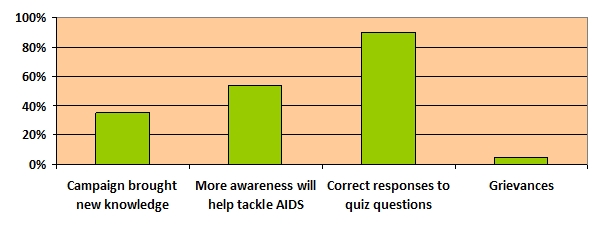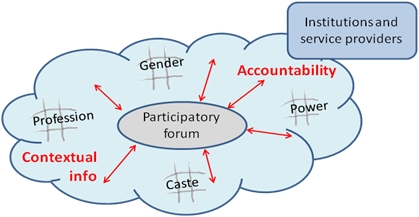Our latest information campaign with Prabhat Khabar is on HIV/AIDS. Over 40 stories were shared, ranging from comments by people on the stigma attached to AIDS, advisories from doctors, and voices from the civil society. A detailed report can be downloaded here.
1. Introduction
Jharkhand Mobile Vaani (JMV) has since the last one year emerged as a common platform for the people of Jharkhand to express their views, share their experiences and address their queries/questions/doubts on a myriad of issues they encounter on a day to day basis in their lives. In this capacity the callers and listeners of JMR have actively taken up issues pertaining to gaps in the service delivery systems of various government schemes, lack of awareness of social issues, better understanding of agricultural practices and others issues. The campaign on AIDS was yet another such attempt to build and enhance awareness about it through structured inputs, on the one hand and to understand the socio-cultural dynamics that exist at the community level through participation from the callers of JMR, on the other.
As the World AIDS Day is celebrated on 1st December, this campaign started on Jharkhand Mobile Vaani on 2nd December 2012, so that we could provide a platform for our callers and listeners to share their understanding and opinions on HIV /AIDS. We set out to achieve the following objectives:
- Understand the prevalent notion and existing awareness about HIV/AIDS
- Build awareness on HIV/ADIS
- Motivate men and women to talk openly about HIV/AIDS
Stats related to the campaign:
- Duration – 2nd December 2012 to 13th December 2012 (12 days)
- Amount of community feedback items received on AIDS – 66
- Number of items published – 37
- Number of users who heard these items – 1562
- Number of local organizations involved in the campaign – 6
- Media partner – Panchayat Nama, Jharkhand
- Districts from which callers participated – Palamu, Dhanbad, Giridih, Bokaro, Garhwa, Ramgarh, Ranchi, Latehar and Chatra
A high degree of participation happened on JMV around the campaign, and revealed that indeed a lot of awareness was missing, but the communities are open to discussing these issues and understand the need for good information to deal with them.
2. Campaign process
The following process was followed to engage the JMV community in discussions around HIV/AIDS:
1. Interviews
- Specialists, experts like NGO/CBO personnel, civil surgeons, activists and health workers gave interviews to JMR correspondents to share information and knowledge on HIV/AIDS. In the span of twelve days, five interviews of experts were published from Plan India, JSACS, Red Cross, and MOIC.
- The interviews aimed to develop an understanding about the common symptoms of the infection, ways and causes through which infection spreads, precautions and care to be taken to avoid the infections. The interviews also aimed to develop and encourage sensitivity towards a HIV affected person. Govt. schemes and benefits available for AIDS patients were also explained in these interviews.
| Dr Virendra Singh, Project Director, JSACS spoke to JMV and shared with the listeners of JMV various information related to AIDS. He said that AIDS is an infection not a disease. HIV is transmitted by three main ways: unprotected sexual contact, exposure to infected body fluids or tissues, and from mother to child during pregnancy, delivery, or breastfeeding. Although with medical technology improving very fast these days the child in the womb of the mother can be protected from being infected.WHO has a programme of awareness called ABC, which means A for abstinence, B for be faithful to your partner and C for condom, as explained by NACO. Person infected by AIDS can stay healthy by regular treatment and proper lifestyle. He said one should have a positive attitude towards life even after being infected by AIDS, as AIDS doesn’t mean the end of life. | Debjani Khan from Plan India, New Delhi shared information on AIDS. She provided a vivid scenario on what is AIDS. She said AIDS is not a disease; rather it’s a virus infection that can spread by various ways. The virus can be easily transmitted through needles and syringes contaminated with HIV-laden blood, blood transfusion during accident or any such crises and unprotected sexual intercourse. Another way it can be transmitted is from infected mother to the child, but now with the help of medical technology the infection could be stopped to a certain point.The most important thing we should do about the infected person is to treat them with care. If we have someone in our family who is infected by HIV AIDS, then the person should be given proper food and care. There are several centers opened by the government namely the ICTC Centers in every district throughout the country, where doctors provide free medicines and ART treatment. And with regular treatment and proper lifestyle one can lead a life as a normal person leads. |
2. Views, opinions, feedback and comments from the community
- The interviews and recorded content helped initiate community response around HIV/AIDS, and witnessed tremendous participation from people. JMV callers shared their views, opinions and experiences about HIV/AIDS.
Excerpts of Comments:
- Manoj Kumar Duti from Kanke block of Ranchi district called up to inform the listeners of JMV that in the Civil Hospital of Ramgarh district there are no provisions of AIDS treatment. So he requested the government to look into the matter.
- Vinod Kumar Pal from Lesliganj block of Palamu district called up to comment on AIDS Campaign. He said that the campaign in JMV is very useful for the listeners.
- Three songs were created on HIV AIDS by Radhu Rai, Mahuda Baghmara Dhanbad, Suryadev Prasad Yadav from Lesliganj, Palamu and Umesh Kumar Turi from Baghmara, Dhanbad. These songs covered causes, symptoms and care for HIV/AIDS.
- Three poems were contributed by Manoj Kumar from Kanke, Ranchi, and Rajmani Yadav from Lesliganj, Palamu, and V.K. Verma from Giridih.
- Radhu Rai from Baghmara, Dhanbad and Suryadev Prasad Yadav from Lesliganj, Palamu shared couplets on AIDS.
- Rajmani Yadav from Lesliganj, Palamu composed a drama on HIV/AIDS and shared it on JMR.

- Significant participation from the community showed that people are ready to talk about these topics in public. Among the 37 callers, at least 19 shared that increased awareness and knowledge on the subject will help tackle the issue with better understanding. They also stressed the need to treat HIV/AIDS patient with compassion and sensitivity. At the same time contributions from the callers also showed that people are ready to talk about such an issue which is both sensitive and to some extent stigmatised in the society.
- It was highlighted that HIV testing is done in any government medical college hospital or district headquarter hospitals. Information was also provided about presence of Integrated Counselling and Testing Centres (ICTC) in every district of Jharkhand, where HIV/AIDS patients can receive counselling and treatment. A few members conveyed negative feedback about the hospitals in their blocks, about how counselling and testing facilities were not available.
- 13 people appreciated the programme and its timeliness. Their comments highlighted the fact that lack of awareness about the causes of this infection further leads to ill-treatment or insensitivity towards individuals affected by it, hence making their struggle more difficult. They stressed that only with increased awareness the stigma and confusions attached to the infection can be dealt. Some of them also urged the listeners of JMR to carry the information forward to other people who might not have been able to listen to the programme
3. Quizzes
- As a follow up of the community interaction, we put up quiz questions to JMV listeners to assess whether the information provided in the campaign was helpful in developing better understanding of HIV/AIDS. We asked three questions: What are ways in which HIV/AIDS spreads, what are the precautions one must take to avoid the spread of the infection, and what kind of outlook should be developed towards an individual infected by HIV/AIDS?
- Over 90% of the callers gave right answers to all three questions.
3. Media and partnerships
The campaign was covered in every detail by Panchayat Nama through its weekly Suno-Suno page. Multiple grassroots and state-level organisations voluntarily participated and provided their inputs for the campaign. These included:
- JSACS
- Red Cross Society
- Vedic Society (Latehar)
- GRID (Palamu)
- IDF (Palamu)
Civil Surgeons, medical officers in-charge of PHCs, and block program managers, also extended their support for the campaign.
In the future, significant offline activity will also be conducted via partners, to hold FGDs, interviews of people from the field, and bring active partnership from organisations working on these issues. This will not only help collect more detailed information but also bring greater and more intensive outreach.
4. Theory of change: Bringing impact through community media
The figure below captures our theory of change of using participatory communication to enhance two community level dynamics, that is, access to contextual information, and sustained accountability loops, which leads to social change.

We know that rural communities are segmented based on caste and power dynamics, with some segments being more aware than others, and able to avail more services than others. This becomes a vicious cycle that we claim can be broken through equitable access to community media forums. These forums allow communities to share information which helps them learn from each other by hearing stories in their own context, and thus improve awareness of their rights and entitlements significantly more than traditional forms of externally originated broadcast communication. This increased awareness helps create demand for services, which is transparently shared on the same forum and improves accountability by allowing communities to cite deficiencies and gaps in service delivery. This also helps generate critical data on service delivery that can be used by policy makers to understand problems and arrive at data-driven objective solutions.


